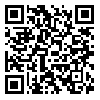Volume 2, Issue 3 (12-2014)
JRIA 2014, 2(3): 28-44 |
Back to browse issues page
Download citation:
BibTeX | RIS | EndNote | Medlars | ProCite | Reference Manager | RefWorks
Send citation to:



BibTeX | RIS | EndNote | Medlars | ProCite | Reference Manager | RefWorks
Send citation to:
(2014). Geometric-spatial evaluation of Tehran contemporary mosques by using thematic analysis of religious texts. JRIA. 2(3), 28-44.
URL: http://jria.iust.ac.ir/article-1-59-en.html
URL: http://jria.iust.ac.ir/article-1-59-en.html
Abstract: (13927 Views)
One of the most important problems in mosques designing is the quality of geometries and spaces which are appropriate for using in these religious buildings. It is obvious that one of the best references for studying this issue is Islamic teachings which are derived from verses and hadith. So, for responding to this question that what are the geometries and spaces which are appropriate for using in contemporary Tehran mosques, all religious texts such as holy Quran and Shia Imams remarks have been investigated. To achieve to the purposes of this research, thematic analysis method has been used for religious texts analyzing. This method is a simple and efficient way to explain patterns in the qualitative data. Using this method, in the first stage, all hadiths and verses which there is the word of “Masjid” or “Masjids” in them - that were about 15,000 ones - were studied. Then those of them which didn’t have effective relation with mosque architecture were omitted and the others were analyzed. Based on analysis of these hadiths and verses three types of code were subsumed. In the first level, descriptive codes were inferred which are the codes that are obvious and unequivocal. In the second level, interpretative codes were inferred which are latent and non-transparent and finally in the third level, pervasive codes were inferred which are the codes that comparing to two other types, have the most comprehensiveness. In this research, after deduction and classification of triple types of codes, the network of themes has inferred this network includes all pervasive codes that have classified hierarchically. In fact, this network provides the conceptual framework for mosques designing.
Moreover, according to the requirements of the various stages of this research, for gathering data, archival research method has been used mostly meanwhile the authors have used logical argumentation method in analysis step and judgment of data (For example, the network of pervasive themes has deducted by logical argumentation method).
The following, regarding to the importance of pervasive themes network, manufacturer principles of this network are cited:
- Balance in permeability in mosques
- Use of abstract geometries and patterns (in association with natural shapes and icons)
- Use of geometries with clear boundaries for spaces separating
- Attending to human scale in mosques
- Use of axial and polar geometries
- Application of uniform and pure geometries in mosques
- Attending to the spatial hierarchy
- The necessity of observing the simplicity in mosque
- Attending to the mosque legibility for pedestrians
- Attending to multi functionalism
- Attending to the traditions and methods of the Holy Prophet (PBUH) and Imams (AS) in the construction of mosques
- The necessity of preserving Islamic identity and avoiding the imitation of other cultures in physical design of the mosques
- Change in original physical patterns of mosques in certain circumstances
- Use of convergent, balanced and introversive geometries and forms in mosques
In the last part of this research, different contemporary mosques in Tehran were selected to be evaluated according to 14 above principles. The quality of selection was based on some valid researches that formerly have been done for Tehran mosques typology. According to these researches, totally six mosques were selected that three ones of them are designed in traditional style and the others are designed innovative.
Based on the results of this research and regarding to 14 above principles, to establish the appropriateness of the appearance and conscience in contemporary Tehran mosques, use of converged, static, balanced and generally introverted geometries and spaces is necessary and contrary to what is seen in some contemporary Tehran mosques over recent years, diverging and extroverted geometries and spaces are not suitable for this problem. But unfortunately and according to findings of this research, these features are less respected in Tehran innovative contemporary mosques compared to Tehran traditional contemporary mosques.
Type of Study: Research |
Subject:
Subject- oriented researches in Islamic architecture and urbanism, eg. Spatial-geometrical ideas, symbols and ornaments
Received: 2015/04/8 | Accepted: 2015/04/8 | Published: 2015/04/8
Received: 2015/04/8 | Accepted: 2015/04/8 | Published: 2015/04/8
| Rights and permissions | |
 |
This work is licensed under a Creative Commons Attribution-NonCommercial 4.0 International License. |




